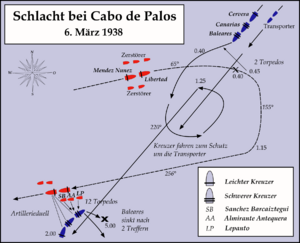Battle of Cape Palos (1938) facts for kids
Quick facts for kids Battle of Cape Palos |
|||||||
|---|---|---|---|---|---|---|---|
| Part of the Spanish Civil War | |||||||
 |
|||||||
|
|||||||
| Belligerents | |||||||
| Commanders and leaders | |||||||
| Adm. Luis González de Ubieta | Adm. Manuel de Vierna y Belando † | ||||||
| Strength | |||||||
| 2 light cruisers 5 destroyers |
2 heavy cruisers 1 light cruiser |
||||||
| Casualties and losses | |||||||
| None | 1 heavy cruiser sunk 765 dead |
||||||
The Battle of Cape Palos was the biggest naval battle of the Spanish Civil War. It happened on the night of March 5–6, 1938. This important fight took place east of Cape Palos, close to Cartagena, Spain, in the Mediterranean Sea.
Why the Battle Happened
On March 5, 1938, two groups of warships were sailing. One group belonged to the Nationalists. They were led by Vice Admiral Manuel Vierna Belando. This group included two large ships called heavy cruisers, Canarias and Baleares. They also had a smaller ship, the light cruiser Almirante Cervera, and three destroyers. These ships were protecting a convoy (a group of ships traveling together). The convoy was carrying war supplies from Italy and soldiers from the Army of Africa. They were sailing across the Strait of Gibraltar.
On the same day, the Spanish Republican Navy also had ships at sea. They were led by Admiral Luis González de Ubieta. His group had two light cruisers, the Libertad and the Méndez Núñez. They also had five destroyers. These ships had sailed from Cartagena. As night fell, the Nationalist destroyers went back to their base. But their cruisers kept sailing.
The Battle Begins
The two groups of ships were sailing in different directions. They met by chance in the dark night of March 5–6, 1938. A Republican destroyer fired torpedoes (underwater missiles), but they missed. Both fleets then passed each other.
Nationalist Rear Admiral de Vierna wanted to wait until morning. He thought the daylight would help his ships use their powerful guns better. But Republican Vice Admiral de Ubieta decided to turn his ships around and chase the enemy.
The ships met again by surprise around 2:15 AM. The Nationalist cruisers started shooting at the Republican ship Libertad from about 5,000 meters away. The Republican cruisers shot back. Then, one Nationalist ship accidentally fired a star shell. This shell lit up their position, showing them to the Republican ships.
While the cruisers were fighting, three Republican destroyers moved away. These destroyers were probably not seen by the Nationalists. At about 3,000 meters away, the destroyers Sánchez Barcáiztegui, Lepanto, and Almirante Antequera each fired four torpedoes. Two or three torpedoes hit the Nationalist ship Baleares. They hit between its front gun towers. This caused the ship's forward magazine (where ammunition is stored) to explode. Many people believe the destroyer Lepanto caused the sinking. Some also say the destroyer Almirante Antequera helped.
Admiral de Vierna, who was on the Baleares, put the safety of his soldiers first. He ordered his ship to fight the Republican fleet. He told his other ships to leave the area. The two remaining Nationalist cruisers quickly sailed away. They left the Baleares behind. The back part of the Baleares stayed afloat. From there, survivors were rescued. British Royal Navy destroyers, Kempenfelt and Boreas, helped save them. Only 441 out of 1,206 crew members were saved. Admiral Vierna was among those who died when the ship sank.
At dawn, the Nationalist cruisers came back. Survivors who had been rescued by the British ship Boreas were moved to the Nationalist ships. Republican bombers then attacked from the air. This attack stopped the rescue and caused one British sailor to die.
What Happened After
The sinking of the Nationalist heavy cruiser Baleares was a huge victory for the Republican government. Luis González de Ubieta, the commander of the Republican fleet, received the Laureate Plate of Madrid. This was the highest military award for bravery in the Second Spanish Republic.
The Distintivo de Madrid, an award for courage, was given to the Republican cruisers Libertad and Méndez Núñez. It was also given to the destroyers Lepanto, Almirante Antequera, and Sánchez Barcáiztegui, and their crews. These ships would then fly a special flag. The crew members would wear a special badge on their uniforms with the old Coat of arms of Madrid.
The Battle of Cape Palos was one of the last victories for the Republican side in the war. Even though it was the biggest naval battle and an important win, it did not change the war's outcome much. The Republican Navy did not use their advantage well. Also, the loss of the Baleares was partly made up for. A few months later, a modernized Nationalist cruiser called Navarra joined their fleet.
See also
 In Spanish: Batalla del cabo de Palos (1938) para niños
In Spanish: Batalla del cabo de Palos (1938) para niños
- Spanish Civil War Republican ship classes
- List of classes of Spanish Nationalist ships of the Spanish Civil War
Images for kids



